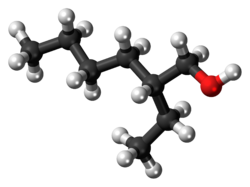 | |
 | |
| Names | |
|---|---|
| Preferred IUPAC name 2-Ethylhexan-1-ol [1] | |
| Other names isooctyl alcohol, 2-ethylhexanol | |
| Identifiers | |
3D model (JSmol) | |
| 1719280 | |
| ChEBI | |
| ChEMBL | |
| ChemSpider | |
| ECHA InfoCard | 100.002.941 |
| EC Number |
|
| KEGG | |
| MeSH | 2-ethylhexanol |
PubChem CID | |
| UNII | |
CompTox Dashboard (EPA) | |
| |
| |
| Properties | |
| CH3CH2CH2CH2CH(CH2CH3)CH2OH | |
| Molar mass | 130.231 g·mol−1 |
| Appearance | Colourless liquid |
| Density | 833 mg/mL |
| Melting point | −76 °C (−105 °F; 197 K) |
| Boiling point | 180 to 186 °C; 356 to 367 °F; 453 to 459 K |
| log P | 2.721 |
| Vapor pressure | 30 Pa (at 20 °C) |
Refractive index (nD) | 1.431 |
| Thermochemistry | |
Heat capacity (C) | 317.5 J/(K·mol) |
Std molar entropy (S⦵298) | 347.0 J/(K·mol) |
Std enthalpy of formation (ΔfH⦵298) | −433.67–−432.09 kJ/mol |
Std enthalpy of combustion (ΔcH⦵298) | −5.28857–−5.28699 MJ/mol |
| Hazards | |
| Occupational safety and health (OHS/OSH): | |
Main hazards | Mildly toxic |
| GHS labelling: | |
 | |
| Danger | |
| H302, H312, H315, H318, H335 | |
| P261, P280, P305+P351+P338 | |
| Flash point | 81 °C (178 °F; 354 K) |
| 290 °C (554 °F; 563 K) | |
| Explosive limits | 0.88–9.7% |
| Lethal dose or concentration (LD, LC): | |
LD50 (median dose) |
|
| NIOSH (US health exposure limits): | |
PEL (Permissible) | none [2] |
REL (Recommended) | TWA 50 ppm (270 mg/m3) (skin) [2] |
IDLH (Immediate danger) | N.D. [2] |
| Related compounds | |
Related alkanol | Propylheptyl alcohol |
Related compounds | |
Except where otherwise noted, data are given for materials in their standard state (at 25 °C [77 °F], 100 kPa). | |
2-Ethylhexanol (abbreviated 2-EH) is an organic compound with the chemical formula C H 3CH2CH2CH2CH(CH2CH3)CH2 OH. It is a branched, eight-carbon chiral alcohol. It is a colorless liquid that is poorly soluble in water but soluble in most organic solvents. It is produced on a large scale (>2,000,000,000 kg/y) for use in numerous applications such as solvents, flavors, and fragrances and especially as a precursor for production of other chemicals such as emollients and plasticizers. [3] It is encountered in plants, fruits, and wines. [4] [5] The odor has been reported as "heavy, earthy, and slightly floral" for the R enantiomer and "a light, sweet floral fragrance" for the S enantiomer. [6] [7]